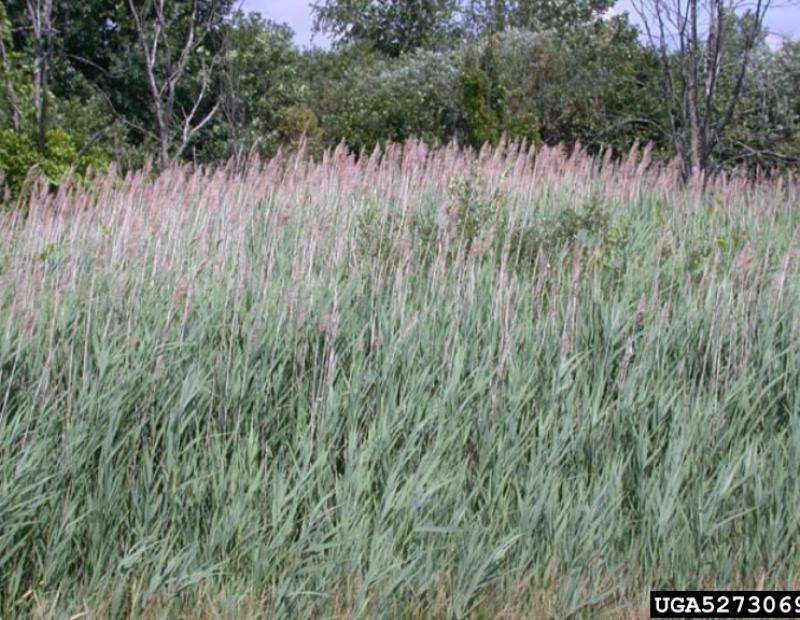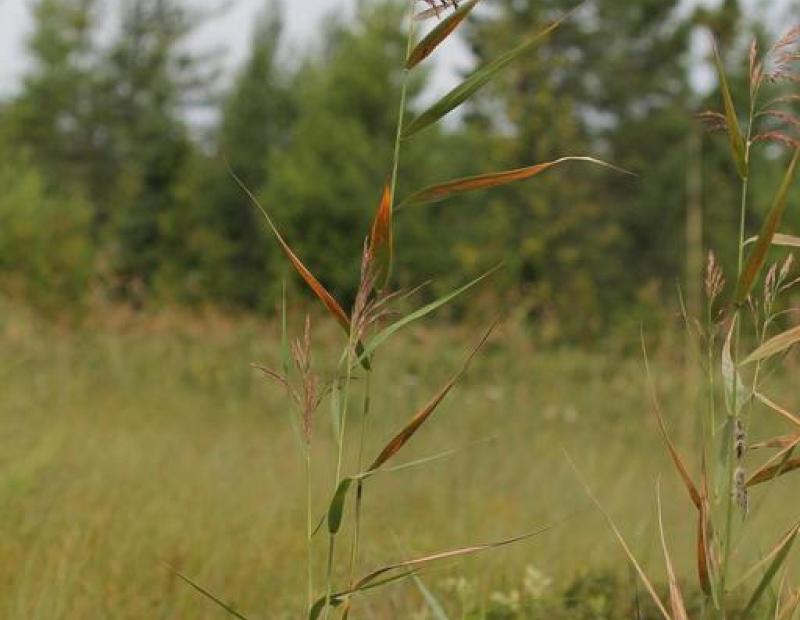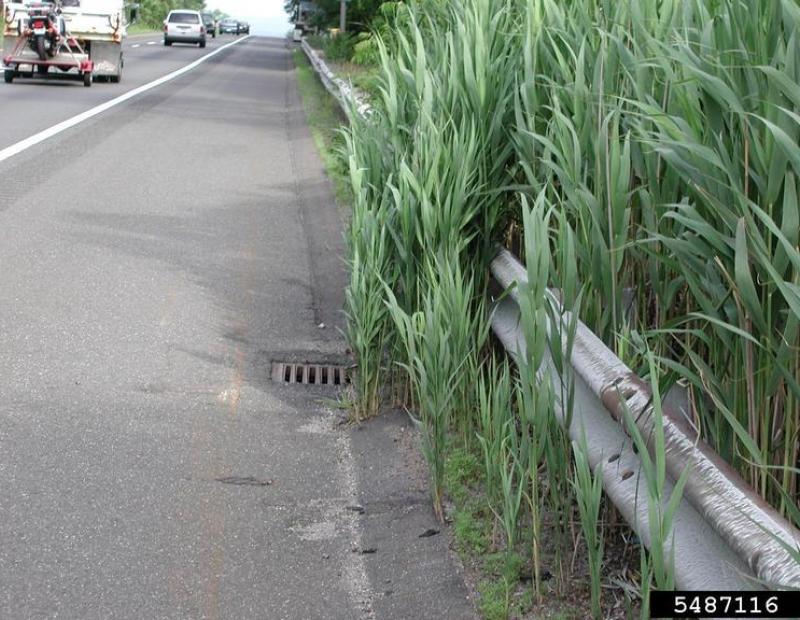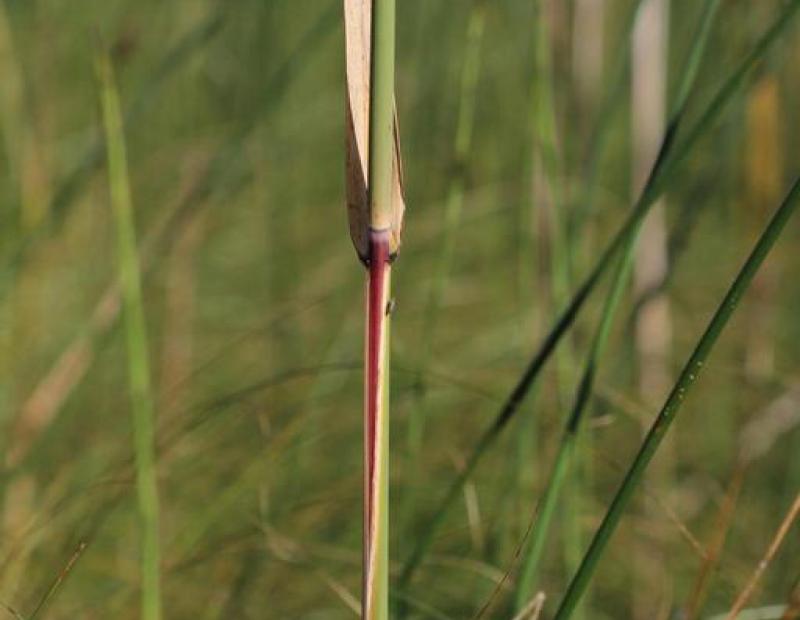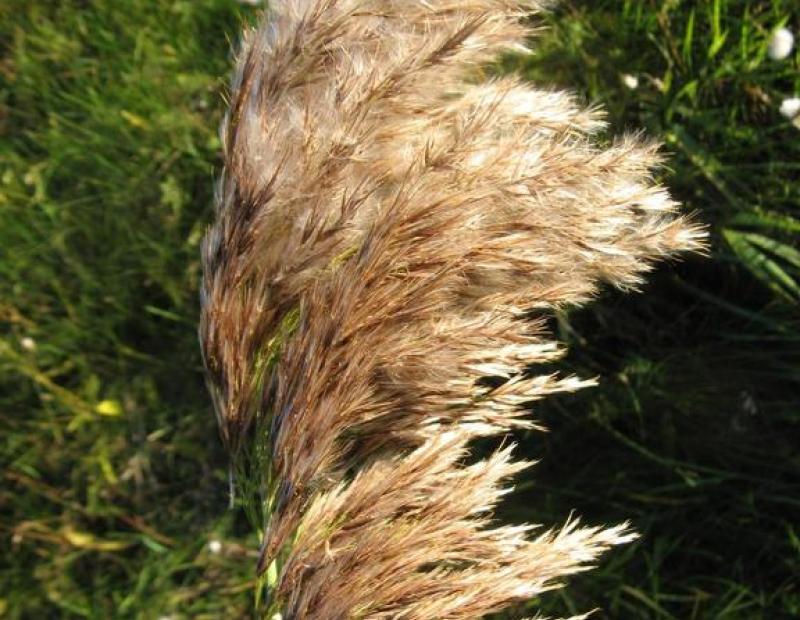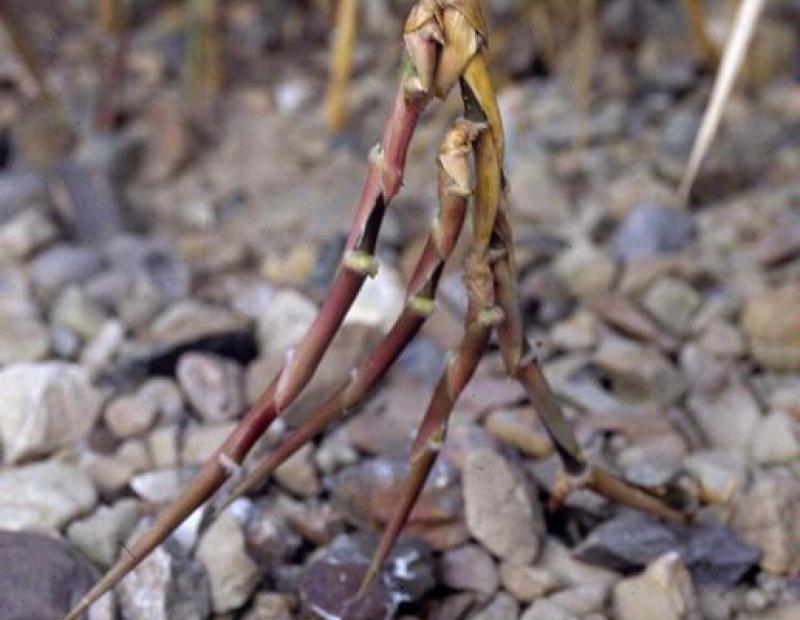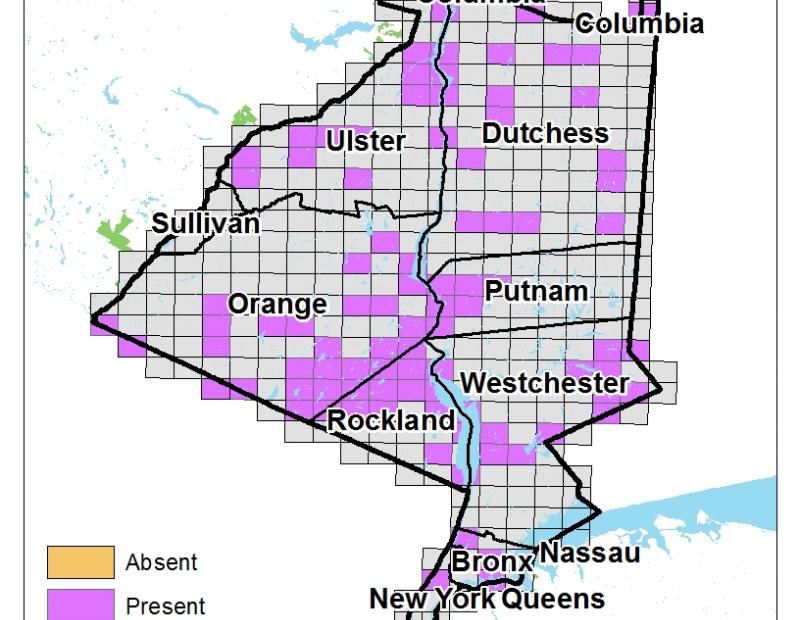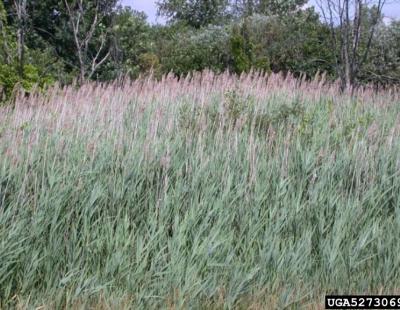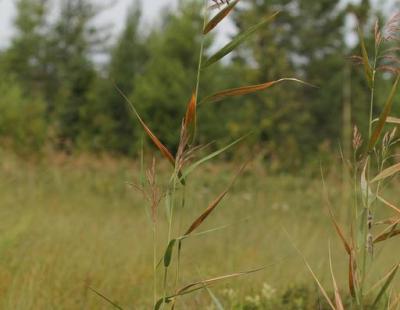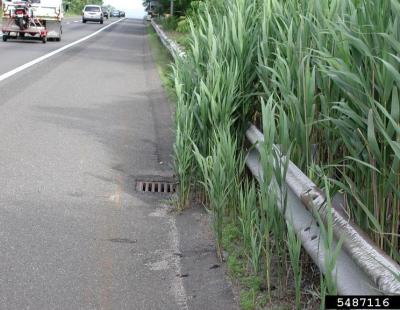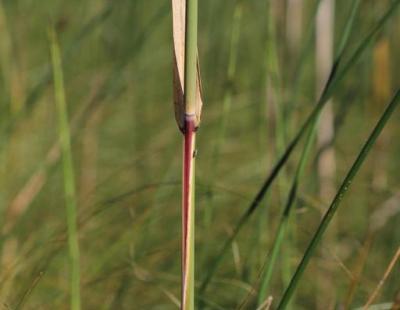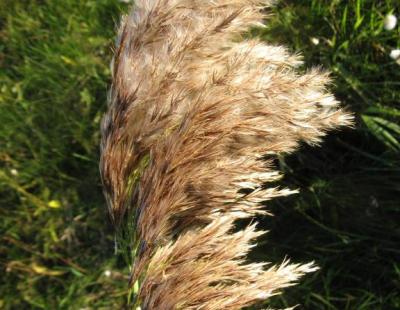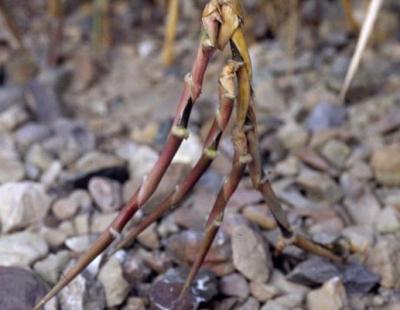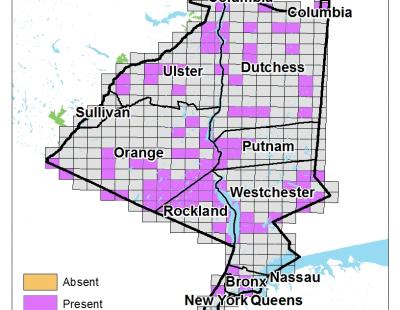Vertical Tabs
A very large, perennial grass, reaching a height of 1-3.5 m (or more), often found in extensive, dense stands in wetlands. Stems are stout, unbranched, and hollow, bearing long, flat leaves on one or two sides. Rhizomes can grow to 20 m long. Large, feathery, plumed flower spikes are produced in August and September and often persist through the winter.
Common reed tends to form dense, extensive, high-biomass colonies. It can substantially modify soil, hydrology, microclimate, and vegetation.3 The interior of a dense reed stand often contains very few other plants. Along the outer margin other plants are commonly admixed, often (at upland edges) including dense vines which use the sturdy grass for support. Reedbeds have supplanted cordgrass (Spartina)-dominated plant communities in brackish tidal marshes, cattail (Typha)-dominated communities in tidal fresh or brackish marshes, and cattail or sedge (Carex)-dominated communities in nontidal marshes and wet meadows. While the density of common reed leads to the supposition that it reduces native plant diversity, colonies may have become established on bare soil, or supplanted a low-diversity, dense stand of a native species such as cattail.3 Removal of common reed often increases native plant diversity, but this phenomenon is generally short-lived without active management.3 Compared to areas dominated with cordgrass and other native salt-marsh vegetation, older reedbeds have less varied wetland microtopography; reduced populations of salt-marsh breeding birds; lower levels of breeding bird activity in general (although some birds, such as red-winged blackbird and marsh wren, prefer to nest in reed); reduced abundance of wintering waterfowl; and decreased use by larval and juvenile mummichog.3
Wetlands and other habitats that have been altered by the disruption of natural hydrology, the addition of fill or pollutants, or other effects of human land use and development may benefit from the habitat values and environmental services of reedbeds. Also, individual reedbeds vary greatly in their ability to provide those values and services based on variables such as stand density, hydrology, etc. Common reed plant parts are eaten by muskrat, eastern cottontail, white-tailed deer, and various insects—including larvae of Henry’s marsh moth (Simyra insularis) and broad-winged skipper (Poanes viator).3 Various bird species forage on the abundant reed scale (insect), insects overwintering within the reed culm, and seeds. (Common reed supports a higher insect biomass than cattail or purple loosestrife.) Reedbeds provide favorable roosting habitat for nonbreeding songbirds, short-eared owl, and other birds, as well as nest sites for certain species. Most livestock will graze on young shoots of common reed, which provides moderately nutritious forage; horses and sometimes cattle also eat the mature foliage. Dense stands provide cover and protection from humans and other predators for mammals such as deer, raccoon, striped skunk, bear, and muskrat. The deep litter layer provides shelter for small animals and food for decomposers. Fish communities are generally comparable between reed and other tidal marsh communities.3
Common reed has a high tolerance for pollution. It sequesters heavy metals, rather than releasing them into the water column. It is commonly used for wastewater treatment and sludge dewatering in water treatment plants. Reed builds up the soil level due to high biomass production and slow decomposition. Dense beds increase sediment deposition and stabilize soils. This can dry wetlands, and decrease access to fish, crabs, and shrimp in tidal wetlands, but the same properties can benefit wetlands in danger of flooding due to sea level rise, or at risk of shore erosion from storms.5
Manual or Mechanical Control
This page focuses on manual best management practices only. Please contact invasives@nynjtc.org with specific questions on chemical or biological control options.
- Very small stands: Hand-dig, being sure to remove the entire rhizome system; or smother by covering with heavy-duty black plastic (after cutting and removing stems) for at least two years; or cut stems repeatedly below water level (see below). Replant with native species.
- Contain stands that threaten to spread into valuable habitat, using ditching (water must be at least 1 m deep and 1 m wide); belowground installation of vertical rigid plastic sheeting (such as [6]) or metal sheet piling; or the previous methods if suitable.
- Monitoring: Mark the boundary of a stand with stakes, establish onsite photopoints, or analyze aerial photos (small or low-density stands may not be visible on aerial photos). Reexamine every 1-2 years, with no management necessary as long as the boundary is stable, declining, or slowly expanding. If rapid expansion occurs, management can start promptly.3
- Plant trees and shrubs to thin and eventually replace reed stands. Common reed around woody plantings will need to be frequently cut or smothered to allow the plantings to establish and grow. Managing nearby areas for maximum canopy density will help limit spread and establishment of new populations. (Planting trees and shrubs—or allowing natural regeneration—in wetland and riparian areas has many other benefits as well, including habitat improvement for breeding birds.)
- Raising water levels may fragment large areas of common reed and create improved marsh and water bird habitat. Restoring tidal flow to diked salt marshes increases salinity and reduces dominance of common reed.3
- Dredging a pond can result in water too deep for common reed to re-colonize. In large wetlands, “scrapes” or large, shallow pools can be excavated to create marsh and water bird habitat.3
- Livestock grazing can be used to manage common reed in pastures, wet meadows, fens, and other open, dry-end wetlands. Goats, or goats and sheep together, have been used successfully to decrease reed height and cover in bog turtle habitat,7 and cattle have also been used for bog turtle habitat management8 and consume reed.3 Goats grazing for 3 rotations of < one month each over a year reduced reed cover and increased plant diversity.9 Their reedbased diet during this time was high enough quality to pose no detriment to health. When livestock are given a larger pasture with more choice, however, reed may be avoided and increase in density.9
- A combination of summer cutting of stems below water level and raising or maintaining high water levels (to keep roots and stems submerged) can result in significant mortality. Grasp the stem with both hands and kick it sideways, breaking it at or near the base (this was easier than clipping with tools in one study).10
- Where muskrats are present (especially in tidal wetlands), the addition of raised structures (hay bales, logs, wooden platforms) within the wetland may encourage muskrats to build lodges, which could help manage common reed.3 Muskrat harvesting of reed is most concentrated within 5-10 m of the winter lodge, but in this area they can create clearings or sparse vegetation.3
- Mowing regularly (e.g., twice a year during the growing season for six years) and removing cut material can reduce reed biomass and increase plant species richness. However, mowing in wetlands can compact and damage soils.3 Cutting once per year in June (with a hand-held brush-cutter) and removing cut material resulted in reduced reed cover and increased cover of other plants.11
Management Goals
- For very small stands: Remove, and restore native plant community.
- For wetlands that are entirely dominated by common reed and where it cannot expand further, and where beneficial habitat functions or ecosystem services outweigh those that are detrimental (in view of management goals and potential nontarget impacts of management), for example, in contaminated sites, or in areas at risk due to sea level rise: No action.
- For smaller stands and the edges of larger stands, where there is no immediate risk to a rare species or community: Monitor.
- For medium-large, dense stands that are threatening a nearby rare species or community: Consult with the NYS DEC or a reed specialist. Containment, grazing, or another strategy may be better depending on the specific community or species.
- For medium-large, dense stands where the goal is habitat improvement: Use a combination of the below methods to slow or prevent spread and create a more varied stand structure, including (for example) areas of shallow open water, forested or shrub swamp, low-density reedbeds, and high-density areas for roosting birds and shelter for other animals.
REFERENCES
- Sarver, M., A. Treher, L. Wilson, R. Naczi, and F.B. Kuehn. 2008. Mistaken identity? Invasive plants and their native look-alikes: An identification guide for the mid-Atlantic. Delaware Department of Agriculture. http://www.nybg.org/files/scientists/rnaczi/Mistaken_Identity_Final.pdf
- Gucker, C.L. 2008. Phragmites australis. In: Fire Effects Information System. U.S. Department of Agriculture, Forest Service, Rocky Mountain Research Station, Fire Sciences Laboratory. http://www.fs.fed.us/database/feis/ [Accessed 12 December, 2016].
- Kiviat, E. 2010. Phragmites management sourcebook for the tidal Hudson River and the northeastern states. Hudsonia Ltd., Annandale NY 12504 USA. Available at hudsonia.org.
- Albert, A., J. Brisson, J. Dubé, and C. Lavoie. 2013. Do woody plants prevent the establishment of common reed along highways? Insights from southern Quebec. Invasive Plant Science and Management 6:585-592.
- Kiviat, E. 2013. Ecosystem services of Phragmites in North America with emphasis on habitat functions. AoB PLANTS 5:plt008.
- DeepRoot Green Infrastructure. HDPE geomembrane for blocking root/rhizome growth. http://www.deeproot.com/products/geomembrane/applications [Accessed 12 December, 2016].
- Tesauro, J. 2001. Restoring wetland habitats with cows and other livestock: A prescribed grazing program to conserve bog turtle habitat in New Jersey. Conservation Biology in Practice 2:26-30.
- Travis, K.B., E. Kiviat, J.Tesauro, L. Stickle, M. Fadden, V. Steckler, and L. Lukas. 2016. Grazing for bog turtle (Glyptemys muhlenbergii) habitat management: Case study of a New York fen. Report to the New York State Department of Environmental Conservation and U.S. Fish and Wildlife Service. Hudsonia, Ltd., Annandale, New York.
- Silliman, B.R., T. Mozdzer, C. Angelini, J.E. Brundage, P. Esselink, J.P. Bakker, K.B. Gedan, J. van de Koppel, and A.H. Baldwin. 2014. Livestock as a potential biological control agent for an invasive wetland plant. PeerJ 2:e567.
- Smith, S.M. 2005. Manual control of Phragmites australis in freshwater ponds of Cape Cod National Seashore, Massachusetts, USA. Journal of Aquatic Plant Management 43:50-53.
- Breen, D.B., S.D. Bailey, and H.A. Violi. 2014. Managing remnant and reemerging common reed (Phragmites australis) infestations to improve treatment efficacy and mitigate damage to native plants. Invasive Plant Science and Management 7:445-453.

